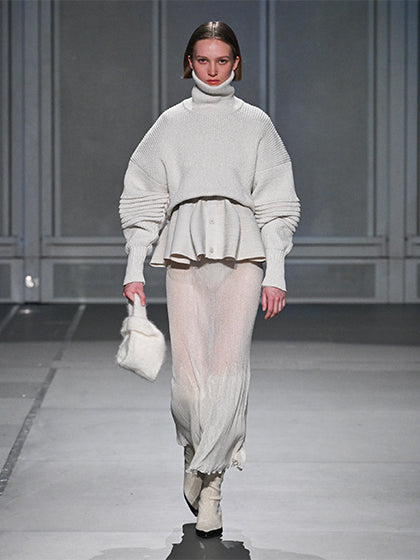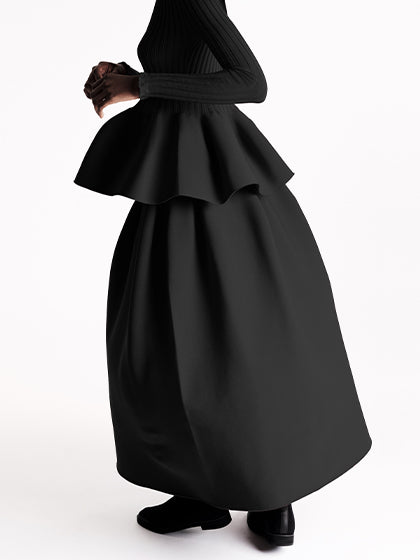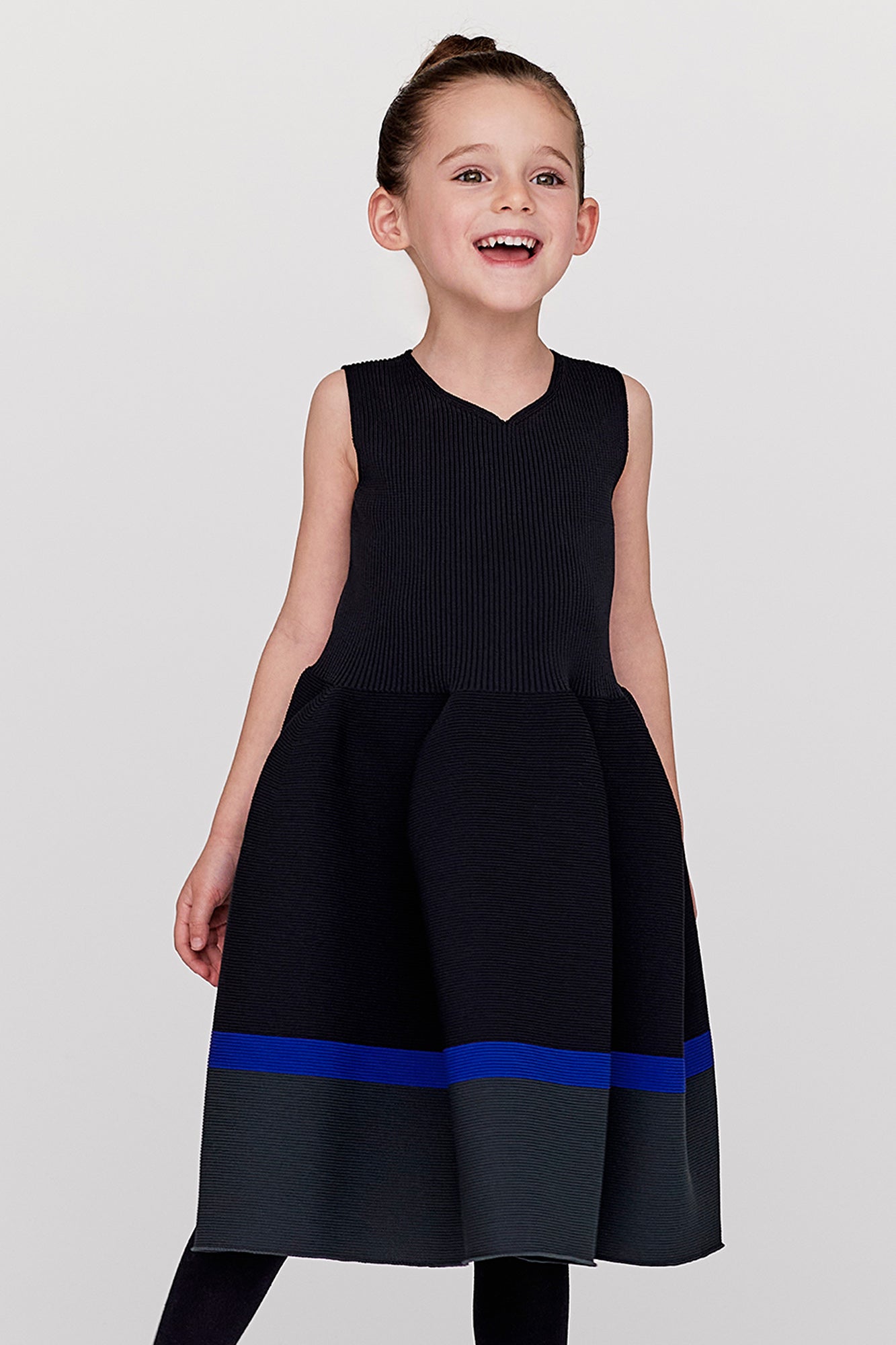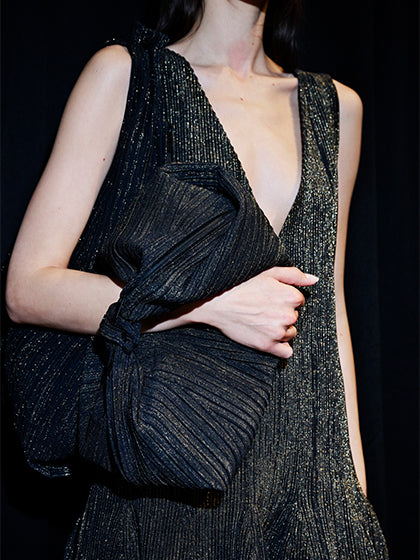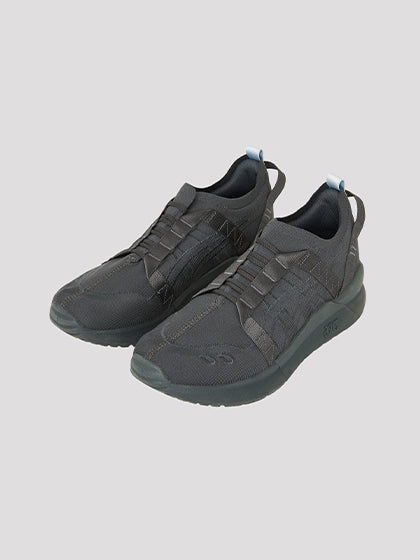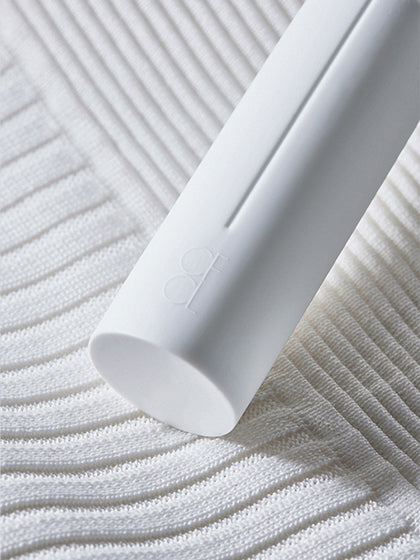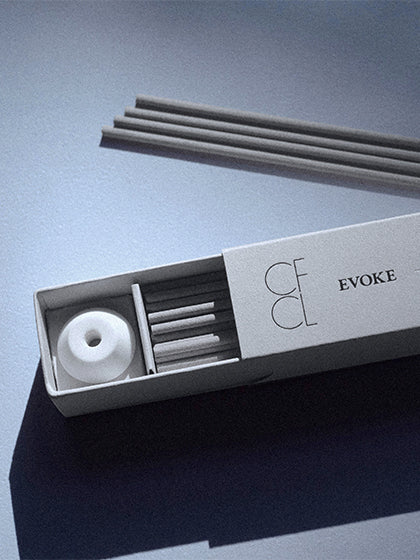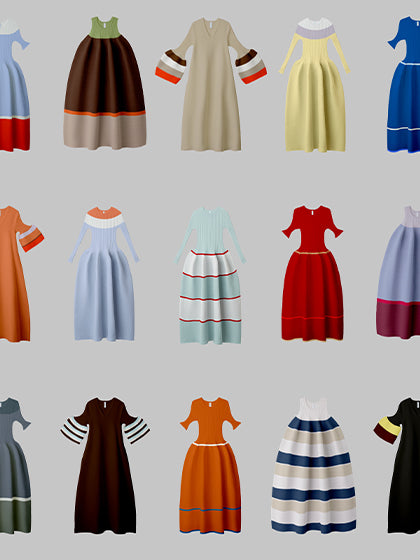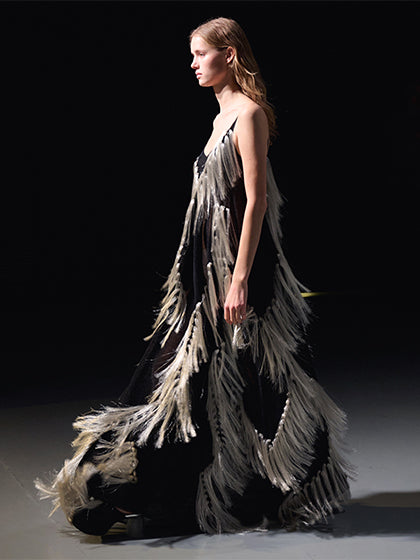
It has been two years since CFCL was certified as a B Corporation on July 28, 2022. Through clothing, our aim since establishment has been creating benefits for the environment, employees, customers, and our community, with socially responsible governance. In the two years since our certification the company has grown substantially. With a corresponding increase in employees, manufacturers and others in the supply chain, new challenges and complexity continue to arise. As we collectively prepare for recertification as a B-Corp next year, we are currently restructuring our sustainability team to further ensure that responsibility is at the center of all our business activities.
Through this Consciousness Report, we unveil our activities throughout the VOL.7 collection as follows:
1. Procurement of Materials
Increased use of materials with guaranteed responsibility for the environment and the working conditions of producers
2. Life Cycle Assessment (LCA)
Verification results for garments made using organic cotton
Verification results for garments made with yarn with a water-repellent-finish
Verification results for bags in the STRATA series
3. Benefit Creation for Our Community
Recruitment of global talent
Flexible working arrangement
Employee skill development training sessions
Figure 1

1. Global Recycled Standard (GRS) is an international product standard that establishes third-party certification requirements for: recycled content; processing and distribution process management; social and environmental practices; and chemical regulations.
2. The Global Organic Textile Standard (GOTS) is an international benchmark established by leading standards organizations. It ensures that textile products are ‘rightly organic’ from the harvesting of raw materials and takes into account environmentally friendly and socially responsible manufacturing with accurate labeling that provides consumers with a credible guarantee.
3. Recycled Claims Standard Certification (RCS) is an international certification which assesses whether or not a final product contains at least 5% recycled materials in its raw materials.
*Fittings and accessories such as buttons, zippers, ties, waist elastic, etc. are not included in this total.
[90.52%]
This represents the percentage of materials used in CFCL’s VOL.7 collection that meet international standards for environmental and social responsibility (presented in Figure 1 above). This is the highest result among the collections presented to date.
Compared to VOL.5 (the same spring/summer collection), we were able to increase the volume of certified materials used in VOL.7 by approximately 1.5 times (Figure 2). This increase was due to:
・switching from virgin polyester to recycled polyester for the MILAN RIB series from VOL.6 onward;
・increasing the use of GRS certified recycled polyester by approximately 10%, alongside decreasing the use of virgin polyester by approximately 17%: and
・expanding the range of products made with GOTS-certified organic cotton, resulting in a 5% increase in organic cotton use.
Figure 2

We source materials with the goal of contributing to a recycling-oriented society by reusing resources instead of extracting new ones. By actively procuring certified materials, we ensure a healthy working environment for their producers and adherence to best environmental practices.
Although the acquisition rate of certified materials was high this year at over 90%, to ensure all of our materials are manufactured in an environmentally and socially responsible manner, the following issues remain to be resolved:
・converting the remaining 4.7% of virgin polyester into recycled materials;
・converting other petroleum-derived fibers such as nylon and polyurethane into recycled materials; and
・converting animal fibers used in the fall/winter collection to certified materials.
Committed to resolving these issues, we will continue to work with our supply chain to continue increasing the proportion of recycled materials, and to achieve our goal of 100% certified materials use by 2030.

We have been conducting LCA since our first season, making this the seventh round of assessment. The number of products we have been able to assess has increased each season, and in VOL.7, 138 out of 232 items (approximately 59%) were included.
Conducting LCA is part of our goal of achieving carbon neutrality by 2030, which has been in place since CFCL was established. At the same time, in expanding the range of designs, the number of materials and accessories we handle has increased each season. As our supply chain grows, new challenges arise.
During the LCA process, we aim to obtain actual data for each production process. With the cooperation of suppliers, we collect actual energy consumption data for the domestic manufacturing process of each item. However, for a number of other processes, it has been difficult to obtain actual data due to a layered supply chain that extends both domestically and internationally, alongside the fact that LCA calculation has not yet become standard practice in the fashion industry.
Accordingly, we refer to a Life Cycle Inventory (LCI) database*1 to calculate LCA for parts where actual values cannot be obtained. CFCL will continue to communicate with suppliers on a daily basis, in order to expand the ratio of actual data.
This report presents the following three topics:
I. LCA Calculation for Garments Made with Cotton
II. LCA Calculation for Garments Using Yarn with a Water-Repellent-Finish
III. LCA Calculation for Bags in the STRATA Series
*1 A Life Cycle Inventory (LCI) database is a specialized repository that contains detailed data about the inputs and outputs associated with the production, use, and disposal of various products and materials. For LCA calculations, CFCL mainly uses IDEA, a database jointly developed by the National Institute of Advanced Industrial Science and Technology and the Japan Environmental Management Association for Industry.
I. LCA Calculation for Garments Made with Cotton
Figure 3

Compared to the VOL.5, the use of GOTS*2 certified organic cotton has increased by approximately 5%. This is due to increased use of a composite yarn made of a combination of organic cotton from India and recycled polyester derived from plastic bottles developed by our suppliers. This cool and breathable material is now used in a total of 18 garments, including the CASCADES, TC MILAN RIB, TC STRATUM, TC HIGH GAUGE, and TC GARTER series.
Though CFCL aims to predominantly use recycled materials, these garments are made with organic rather than recycled cotton because the quality of recycled cotton on the market does not yet meet the design quality standards of CFCL. Due to the following reasons, we use organic cotton, which accounts for only 1.4% of global cotton production*3.
・The cultivation methods are guaranteed to consider the soil environment of fields without the use of harmful pesticides and chemical fertilizers.
・We consider the human rights, safety, health, and working environment of workers.
As the local cultivation methods and climate conditions vary in each country and region, it was difficult to obtain LCA data specific to the organic cotton used in this collection. Therefore, we referred to the LCI database for conventional cotton for these LCA calculations. The results are presented in Figure 3.
This process revealed that the CO2 emissions for this cotton composite are higher than that of recycled polyester. Although there are differences in the manufacturing process, emissions are higher for the CASCADES SLEEVELESS TIERED MINI DRESS than that of POTTERY SHORT BELL SLEEVE FLARE DRESS (521g) 2.39 kg-CO2e/1pc made of recycled polyester, which has a similar product weight (displayed in Figure 4 below).
*The POTTERY SHORT BELL SLEEVE FLARE DRESS obtained a non-fossil certificate*4 at the knitting process factory and, with an offset of 1.83 kg-CO2e/1pc, resulting in 2.39 kg-CO2e/1pc of actual emissions.
Figure 4

Additionally, we were unable to make direct communication with local cotton producers and therefore could not measure CO2 emissions based on actual organic cotton production.
With transparency issues becoming apparent in this process, we will change the organic cotton raw material supplier we work with from VOL.8. Starting from seed selection and cotton cultivation by local farmers in India, we are working with suppliers to ensure traceability and positive contribution to local communities. We will report our progress in future Consciousness Reports, with targets to:
・carry out LCA calculations based on actual data from organic cotton we use (including a comparison with conventional cotton);
・track contribution of benefits to local producers; and
・investigate the use of recycled cotton in pursuit of carbon neutrality.
*2 GLOBAL ORGANIC TEXTILE STANDARD https://global-standard.org/downloads
*3 Textile Exchange, Organic Cotton Market Report 2022,17P
https://textileexchange.org/app/uploads/2022/10/Textile-Exchange_OCMR_2022.pdf
*4 An environmental certification certifying that the power was generated from a non-fossil source with no CO2 emissions, namely renewable energy.
II. LCA Calculation for Garments Made with Yarn with a Water-Repellent Finish
Figure 5

The material used in this collection is a recycled polyester derived from plastic bottles and treated with a water-repellent finish. This combination, together with the characteristics of the knitted fabric, gives the fabric a taut, three-dimensional feel, creating a distinctive form.
This material was first used in the MESH and HYPHA depicted above and will be used for more items in the future. In VOL.7 it was used in 7 garments (2.4% of the total items). In order to evaluate the environmental impacts of this material, we have undertaken LCA calculations for its production process. See Figure 5 for the emissions results.
In recent years, restriction of “PFAS” (organic fluorine compounds)*5 have become widely recognized in the apparel industry. PFAS are found in water repellents and many global brands are reviewing their use due to non-biodegradable properties. Last year we discovered that the water repellent used in this material was a C6 water repellent (PFHxA); which will be regulated in some US states from January 2025. We then sought to switch from C6 water repellent to another water repellent but were unable to maintain the quality we sought in our designs while achieving prototyping timelines and mass production stability in this collection.
There was a lack of awareness surrounding the properties of water repellents in the design phase. To address this issue, we will review our organizational processes, to ensure appropriate decisions can be made at the material selection stage. In addition, the following measures will be implemented:
・switch to C0 water repellent from VOL.9 – December 2024 (C6 water repellent was used until VOL. 8); and
・develop new materials in cooperation with raw material suppliers/knitting factories to avoid the use of water-repellent materials
*5 Ministry of the Environment Expert Meeting on Comprehensive Strategy for PFAS (1st Meeting) Agenda and Handouts
https://www.env.go.jp/water/pfas/pfas_00001.html
Ⅲ. LCA calculation of bags in the STRATA series
Figure 6

Up until VOL.6, we have undertaken LCA for garments only. In VOL.7 for the first time, we have taken on the challenge of calculating the emissions stemming from bags too. The items assessed were the STRATA series, which has been in production since VOL.3. The unique silhouette combines pin-tucks and ribs, and is produced in ranging styles including a sacoche, knapsack, and tote bag.
Product and manufacturing features of the STRATA series:
・made of recycled polyester derived from plastic bottles
・include metal fittings (made of brass and zinc)
・heat-processed with partially fused yarn (virgin nylon) to maintain product strength*6
*6 Heat processing involves partially fusing the yarn with virgin nylon to reinforce strength. Because the actual input is resin, heat processed finished products are categorized according to regulation as 100% recycled polyester on product labeling.
In order to identify greenhouse gas (GHG) emissions for the STRATA series bags, including the fittings and heat-processing mentioned above, we surveyed each supplier in raw material procurement, processing, product manufacturing, and transportation.
Regarding metal fittings, the survey revealed that some accessories were manufactured with 100% recycled metals procured domestically in Japan, but the remainder were made from minerals imported from Australia and other foreign countries. Additionally, due to difficulties in communicating with those further up the metal supply chain (both overseas and domestic), detailed information could not be identified.
We therefore made the calculations with reference to the LCI database and related literature.*7 See Figure 6 for the calculation results.
The problems and issues identified as a result of this process are described below.
Heat-processed yarn: Although accounting for 4% of the total on a weight basis, thermally bonded yarn (virgin nylon) accounts for 12% of the total emissions. This is because thermally bonded yarn is a virgin material that is procured from newly mined oil, with a relatively high degree of greenhouse gas emissions.
Metal fittings: Metal accessories account for 7% to 36% of emissions per bag, depending on the weight of the item. Emissions are particularly high in the plating process (where multiple chemicals are used), with approximately 90% of emissions from metal processing derived from the plating process.
In previous reports, we have discussed the relatively high GHG emissions of garments made from virgin polyester. Therefore, we have been procuring materials with the intention of selecting recycled materials from the design stage, and shifting existing garments to recycled materials, as we did with the MILAN RIB series in VOL.6. This season, around 8% of the total fabrics are made of petroleum-derived virgin materials. It is difficult to find alternative inputs that can achieve the design and functionality that CFCL seeks, but we will continue to discuss with manufacturers to explore the possibility of switching the remaining portion of virgin polyester.
From the VOL.8 collection, CFCL has made efforts to reduce the amount of metal accessories used in the design stage of the STRATA series; by decreasing the number of locations we use the accessories from two to one. At the same time, as we still lack information on metal procurement, we plan to continue researching more appropriate options based on examples from other companies.
*7 Tadashi Doi “Control of plating solution components”. The Japan Society for Analytical Chemistry. 200605kougi.pdf (jsac.or.jp)
Databases used in LCA calculation:
・IDEA Version 3.3, National Institute of Advanced Industrial Science and Technology (AIST), Safety Science Research
Division, IDEA Lab.
Since establishment, CFCL has aspired to be a global company that offers a more lifestyle-oriented working style for diverse employees. As the company grows, we have more employees from various backgrounds, and are focusing on creating an environment which is accommodating to all.
As mentioned above, we are currently working towards B Corporation re-certification. With company growth, the number of questions in our B Impact Assessment*8 has increased about 40 questions. Within the ‘Workers’ section, it has become clear there is still much we can do. In particular, we have realized that our understanding of JEDI (Justice, Equity, Diversity and Inclusion), is not yet sufficient. We will continue to study to deepen our understanding, while reporting below our actions to date with respect to these areas.
*8 B Impact Assessment is a set of questions that B Lab uses to evaluate companies for B Corporation certification.
Website: https://www.bcorporation.net/en-us/programs-and-tools/b-impact-assessment/
I. Recruitment of Global Personnel
Figure 7

Currently, 26.9% of CFCL employees have a global background. This includes foreign nationals (13.5% of employees) and Japanese employees who have lived abroad (13.4%). We have a wide variety of recruitment methods, including recruiting an employee of Ukrainian nationality through the Non-Profit Organization WELgee*9. We value the skills and potential of our employees irrespective of background, and are committed to promoting a flexible and diverse workplace culture.
*9 NPO WELgee website: https://www.welgee.jp/programs
II. Flexible Working System
CFCL has a flexible working system, under which employees can either work in the office or remotely up to 3 times a week. Moreover, we aim to create a working environment with flexibility for staff with children, those working in rural areas or from overseas, and those from diverse backgrounds.
In Japan, the Government is taking measures to create a better working environment for women in society, through efforts such as the Work Style Reform and Act on the Promotion of Women’s Active Engagement in Professional Life. Despite this, many women still bear a disproportionate burden of housework and childcare, and hurdles remain for women in the workforce. Especially for those with children whom they must pick up from school and prepare meals for, the traditional system of office-based fixed hour work is inflexible. These individuals are often left with no option but part-time work.
Currently, 29% of CFCL employees have children, of which 28% are male and 72% are female. All employees who are working flexible hours or predominantly remotely are full-time. Some staff members have moved to CFCL to work full-time after maternity leave, because they were unable to do so while raising children at their previous company.
In April, we also signed a contract with a new staff member who lives permanently overseas, operating on a full-remote basis with accommodation for the time difference. In the future, we plan to introduce a full-time full-remote system, actively recruiting global personnel living outside of Japan, alongside those who for whatever reason are unable to commute to the office.
III. Employee Skill Development
Figure 8

With a focus on upskilling employees, CFCL invites internal and external experts in various fields to host regular training sessions. To date, sessions have been held on the sociology of fashion, laws related to fashion, reading financial reports, basics of merchandising, basics in MS excel and perfume-making.
We also offer staff language-training support, sponsoring those who wish to take classes to improve their second language, (including English, Japanese, French, and Chinese). Furthermore, to deepen the understanding of design intentions of the brand and to develop and share cultural capital as our Creative Director, employees are provided tickets to art exhibitions and shows on a quarterly basis.
In order to continue creating a flexible work environment for diverse members, we are currently working on a bottom-up system, where employees can create their own change relating to welfare and childcare. We have plans to introduce a work-vacation program that allows employees to work while vacationing away from their everyday environment. Finally, we are preparing for a company-wide workshop on JEDI which refers to justice, equality, diversity and inclusion, to deepen our understanding and take new steps forward in these areas.



